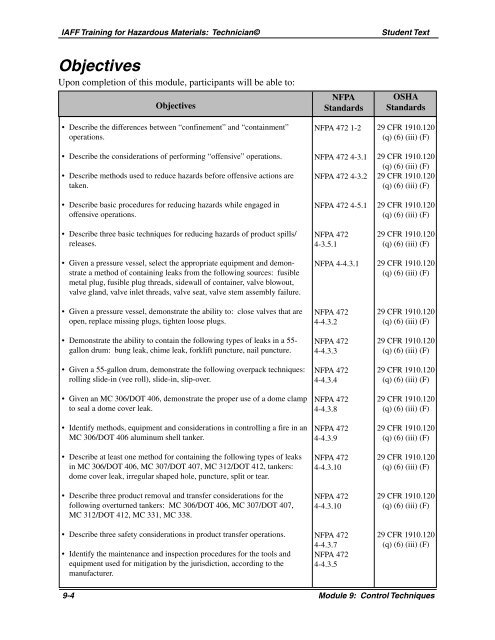Module 9: Control Techniques - International Association of Fire ...
Module 9: Control Techniques - International Association of Fire ...
Module 9: Control Techniques - International Association of Fire ...
Create successful ePaper yourself
Turn your PDF publications into a flip-book with our unique Google optimized e-Paper software.
IAFF Training for Hazardous Materials: Technician©<br />
Student Text<br />
Objectives<br />
Upon completion <strong>of</strong> this module, participants will be able to:<br />
Objectives<br />
• Describe the differences between “confinement” and “containment”<br />
operations.<br />
• Describe the considerations <strong>of</strong> performing “<strong>of</strong>fensive” operations.<br />
• Describe methods used to reduce hazards before <strong>of</strong>fensive actions are<br />
taken.<br />
• Describe basic procedures for reducing hazards while engaged in<br />
<strong>of</strong>fensive operations.<br />
• Describe three basic techniques for reducing hazards <strong>of</strong> product spills/<br />
releases.<br />
• Given a pressure vessel, select the appropriate equipment and demonstrate<br />
a method <strong>of</strong> containing leaks from the following sources: fusible<br />
metal plug, fusible plug threads, sidewall <strong>of</strong> container, valve blowout,<br />
valve gland, valve inlet threads, valve seat, valve stem assembly failure.<br />
• Given a pressure vessel, demonstrate the ability to: close valves that are<br />
open, replace missing plugs, tighten loose plugs.<br />
• Demonstrate the ability to contain the following types <strong>of</strong> leaks in a 55-<br />
gallon drum: bung leak, chime leak, forklift puncture, nail puncture.<br />
• Given a 55-gallon drum, demonstrate the following overpack techniques:<br />
rolling slide-in (vee roll), slide-in, slip-over.<br />
• Given an MC 306/DOT 406, demonstrate the proper use <strong>of</strong> a dome clamp<br />
to seal a dome cover leak.<br />
• Identify methods, equipment and considerations in controlling a fire in an<br />
MC 306/DOT 406 aluminum shell tanker.<br />
• Describe at least one method for containing the following types <strong>of</strong> leaks<br />
in MC 306/DOT 406, MC 307/DOT 407, MC 312/DOT 412, tankers:<br />
dome cover leak, irregular shaped hole, puncture, split or tear.<br />
• Describe three product removal and transfer considerations for the<br />
following overturned tankers: MC 306/DOT 406, MC 307/DOT 407,<br />
MC 312/DOT 412, MC 331, MC 338.<br />
• Describe three safety considerations in product transfer operations.<br />
• Identify the maintenance and inspection procedures for the tools and<br />
equipment used for mitigation by the jurisdiction, according to the<br />
manufacturer.<br />
NFPA<br />
Standards<br />
NFPA 472 1-2<br />
NFPA 472 4-3.1<br />
NFPA 472 4-3.2<br />
NFPA 472 4-5.1<br />
NFPA 472<br />
4-3.5.1<br />
NFPA 4-4.3.1<br />
NFPA 472<br />
4-4.3.2<br />
NFPA 472<br />
4-4.3.3<br />
NFPA 472<br />
4-4.3.4<br />
NFPA 472<br />
4-4.3.8<br />
NFPA 472<br />
4-4.3.9<br />
NFPA 472<br />
4-4.3.10<br />
NFPA 472<br />
4-4.3.10<br />
NFPA 472<br />
4-4.3.7<br />
NFPA 472<br />
4-4.3.5<br />
OSHA<br />
Standards<br />
29 CFR 1910.120<br />
(q) (6) (iii) (F)<br />
29 CFR 1910.120<br />
(q) (6) (iii) (F)<br />
29 CFR 1910.120<br />
(q) (6) (iii) (F)<br />
29 CFR 1910.120<br />
(q) (6) (iii) (F)<br />
29 CFR 1910.120<br />
(q) (6) (iii) (F)<br />
29 CFR 1910.120<br />
(q) (6) (iii) (F)<br />
29 CFR 1910.120<br />
(q) (6) (iii) (F)<br />
29 CFR 1910.120<br />
(q) (6) (iii) (F)<br />
29 CFR 1910.120<br />
(q) (6) (iii) (F)<br />
29 CFR 1910.120<br />
(q) (6) (iii) (F)<br />
29 CFR 1910.120<br />
(q) (6) (iii) (F)<br />
29 CFR 1910.120<br />
(q) (6) (iii) (F)<br />
29 CFR 1910.120<br />
(q) (6) (iii) (F)<br />
29 CFR 1910.120<br />
(q) (6) (iii) (F)<br />
9-4 <strong>Module</strong> 9: <strong>Control</strong> <strong>Techniques</strong>
















